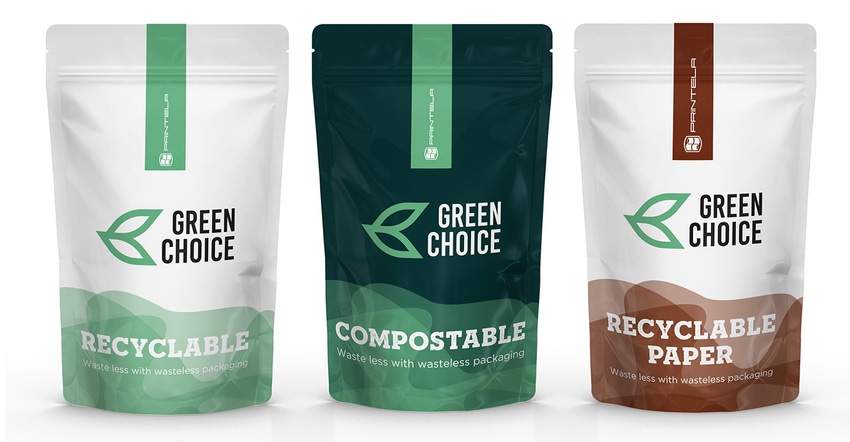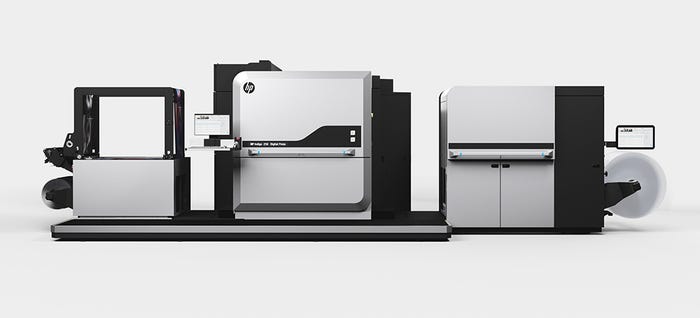Digitally printed recyclable mono-polyethylene (MOPE) films available globally can replace PET and other nonrecycled pouches, films, and labels.

It’s good to offer greener options for highly popular flexible packaging in 2021, but it’s even better to offer those materials validated for use with the rapid turnaround and graphics’ agility enabled by digital printing.
Polysack Flexible Packaging, a green-tech manufacturer of plastic film products for flexible packaging and high-shrink labels, collaborated with HP Indigo to validate its innovative, fully recyclable Polyphane Pack’N’Cycle packaging films for printing on HP Indigo digital presses.
These films have been sold to companies serving 45% of the European plastic flexible packaging market and used for more than 130 recyclable packaging projects. Formats include fully recyclable stand-up pouches, films, and shrink labels that can be found in supermarkets, convenience stores, and gas stations worldwide.
“The ability to combine our 100% recyclable film with HP Indigo’s printing capabilities allows businesses to create packaging that fits their brand while remaining environmentally conscious,” says Yanir Aharonson, CEO of Polysack. “Plastic waste is a major environmental problem, and we’re glad to help make the world a little greener.”
Polysack’s unique film can replace 70% to 80% of unrecyclable plastic with 100% recyclable packaging without increasing costs, modifying people’s usage habits, or needing to rebuild the infrastructure for the package production, according to Aharonson.

Printela, a flexible packaging converter based in Lithuania, has chosen Polysack’s recyclable film combined with HP Indigo’s digital printing press (shown above) to create customized, eco-friendly packaging.
“By using Polysack’s Pack’N’Cycle films, Printela’s HP Indigo Digital Pouch Factory efficiently produces different recyclable pouches consistently, says Valdas Buksnys, general manager of Printela. “Pack’N’Cycle by Polysack is an efficient polyester (PET) replacement film.”
“We are excited to help brands find new packaging options for their products to continue to improve their sustainability profile,” notes Yair Gellis, head of Flexible Packaging development at HP Indigo. “The HP Indigo digital printing solution for flexible packaging offers brands sustainability advantages including lower waste.”
Pack’N’Cycle details and properties.
Pack’N’Cycle films are MOPE — mono-oriented polyethylene, Aharonson tells PlasticsToday. “These can be used for a variety of flexible packaging including lidding films, pouches, flow packs, and many others. Another use is producing shrink labels for PET containers that can be fully recyclable. This technology is patented and can be used for candy wraps and almost any flexible plastic package you can imagine. The films have high tensile strength, high gloss, low haze, controlled shrink ability, easy-tear and straight-pouch opening, recyclable package handles, recycled protective films, and more. Available thicknesses range from 15 to 50 microns. These materials are what we call ‘Recyclability by Design’.”
According to Aharonson, packaging made using Pack’N’Cycle film receives the highest recyclability score according to Circular Economy and sustainability foundations such as Ellen MacArthur or CEFLEX.
“These materials can be placed into a recycling bin from which they can be collected, then grinded, cleaned, and remade into pellets that can be reused for the production of plastic products,” he says.
The packaging made from the films have broad applicability.
“We target all flexible packaging markets including pet food, dry food, dairy, pharma, confectionery, beverages, and agriculture,” Aharonson explains. “Our film can be used for a myriad of plastic packaging including 3-side-seal pouches, gusseted bags, stand-up pouches, spouted pouches, zipper pouches, vacuum bags, sachets, flow packs, and more. These categories may come in different sizes and can be used to pack different contents such as dry, fresh, and frozen foods including vegetables and meat as well as for cement and cleaning liquids.”
The size range is equally wide.
“We know our customers use them for sachets of one or two grams and for food bags as large as 25 kilograms. They can be printed using flexographic, rotogravure, and now digital print methods.”
The films have proven a resounding success. “The demand for our film grew more than 350% annually throughout the past two years,” Aharonson says.
The films are available globally and for any US converter through Polysack’s service locations.
More advances are ahead. “We are currently working on an applications of MOPE for lids and for high-barrier properties,” Aharonson tells PlasticsToday.
About the Author(s)
You May Also Like




